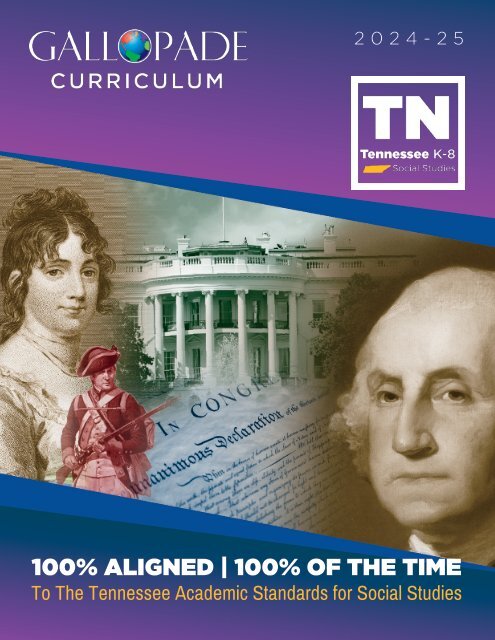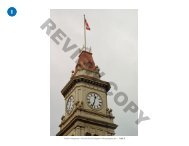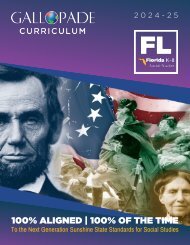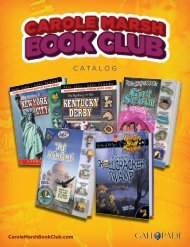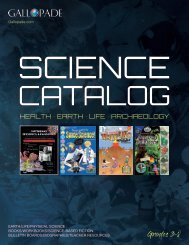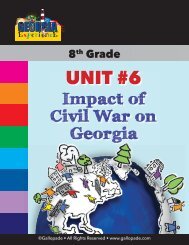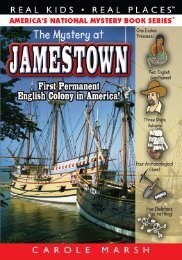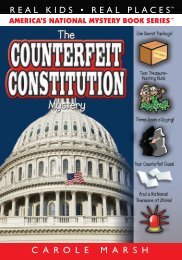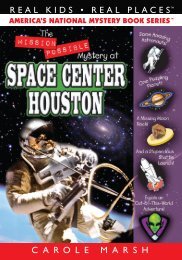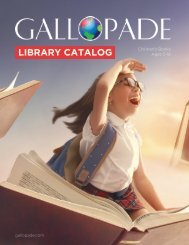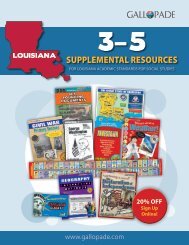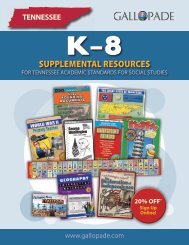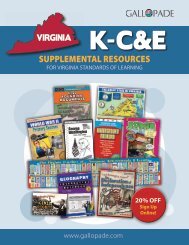Tennessee Curriculum Catalog
Grades K-8 Social Studies Curriculum Catalog.
Grades K-8 Social Studies Curriculum Catalog.
You also want an ePaper? Increase the reach of your titles
YUMPU automatically turns print PDFs into web optimized ePapers that Google loves.
2 0 2 4 - 2 5<br />
100% ALIGNED | 100% OF THE TIME<br />
To The <strong>Tennessee</strong> Academic Standards for Social Studies
GALLOPADE MAKES<br />
TEACHING EASIER<br />
For over 44 years, Gallopade has partnered with<br />
educators to create curriculum and supplemental<br />
resources that provide an array of grade-appropriate<br />
resources to teach, test, and measure for Social<br />
Studies standards mastery.<br />
We offer a comprehensive and flexible program designed<br />
to engage students in a robust and interactive<br />
learning experience 100% aligned with the <strong>Tennessee</strong><br />
Academic Standards for Social Studies.<br />
Gallopade combines print and digital tools such<br />
as primary source analysis, writing prompts, and<br />
project-based learning to create a dynamic learning<br />
platform built for your state. Gallopade <strong>Curriculum</strong><br />
gives students the tools necessary to thrive in their<br />
academic endeavors as they build their skill sets,<br />
boost their confidence, and develop a passion for<br />
learning.<br />
WHY GALLOPADE?<br />
We make teaching easier and learning fun! Gallopade <strong>Curriculum</strong> incorporates proven methods, abundant<br />
resources, the ability to adjust and differentiate, and the flexibility you need in the classroom - all 100%<br />
aligned with your state’s standards.<br />
Standards Aligned<br />
Gallopade <strong>Curriculum</strong> is written and curated to<br />
align completely with the <strong>Tennessee</strong> Academic<br />
Standards. When standards change, the Gallopade<br />
<strong>Curriculum</strong> changes with them.<br />
Evidence-Based<br />
Our proven “small bites” approach helps students<br />
of all learning styles understand and retain essential<br />
Social Studies standards and skills.<br />
Flexible<br />
Gallopade offers print resources and online access<br />
to pre-organized and assignable content, tools, and<br />
resources for teachers and students suitable for all<br />
learning environments.<br />
Consumable<br />
Students receive new books at the start of each<br />
school year. The Student Book is their own to mark<br />
up and write in, and they can also make annotations<br />
in their digital Student Book.<br />
Proven<br />
Our partners love our program. Teachers say that<br />
Gallopade <strong>Curriculum</strong> makes their jobs easier, and<br />
they don’t require additional resources to cover Social<br />
Studies standards. Gallopade’s methods and<br />
approach make students more engaged<br />
and involved with the subject.<br />
Organized<br />
Gallopade <strong>Curriculum</strong> provides everything needed<br />
to teach the standards. Content is organized by units<br />
and chapters, allowing teachers to easily locate and<br />
assign content, activities, assessments, and grade<br />
assignments.<br />
pg.2 | gallopadecurriculum.com
GALLOPADE’S<br />
APPROACH<br />
Gallopade <strong>Curriculum</strong> uses multiple evidence-based theories to achieve<br />
success in education. Core strategies throughout the program include<br />
chunking content, interactive learning methods, and an emphasis on<br />
standards-based instruction.<br />
By using the concept of chunking, or “small bites,” students efficiently process<br />
and place knowledge into their short-term memory without overwhelming<br />
their cognitive load.<br />
We pair this approach with reinforcement activities that support<br />
interactive learning. As students work through the lessons and<br />
activities, they engage in critical thinking exercises related<br />
to content. As they reflect upon those experiences,<br />
they gain a deeper understanding as the information<br />
solidifies in their long-term memory.<br />
Other pedagogical methodologies include connecting<br />
prior knowledge to new knowledge, scaffolding<br />
through predictable patterns and routines,<br />
formative and summative assessments, and<br />
using data to improve student performance.<br />
Gallopade <strong>Curriculum</strong> is accessible and appropriate<br />
for a variety of learning styles. Students<br />
are engaged with the subject matter to help<br />
achieve standards mastery and to foster a passion<br />
for Social Studies and lifelong learning.<br />
2024-2025 | pg. 3
GALLOPADE CURRICULUM INCLUDES<br />
Students and educators need a solution that is effective, easy to use, and flexible to allow teacher customization. Gallopade provides<br />
various resources in multiple formats, along with instructional strategies and implementation ideas, so that educators can tailor lessons<br />
to the specific needs of their classes to create an engaging learning experience for students of all learning styles.<br />
STUDENT BOOK<br />
Gallopade combines content with interactive activities to<br />
create a unique Student Book beyond traditional textbooks.<br />
EXPERTRACK ASSESSMENTS<br />
Auto-graded and pre-built Checkpoint, Benchmark, and<br />
End-of-Year assessments cover core content and skills,<br />
as well as End-of-Semester assessments for grades 3-8.<br />
TEACHER’S EDITION<br />
The Teacher’s Edition provides a variety of ready-to-use<br />
and easily adaptable materials for classroom instruction,<br />
as well as answers to all questions and activities, planning<br />
pages, and pacing guides.<br />
TEACHING TOOLS<br />
Assignable tools and activities that add rigor to instruction<br />
with a focus on inquiry, critical thinking, writing, literacy,<br />
and processing skills.<br />
GRADING + REPORTING<br />
Easily measure and assess student success with district,<br />
school, class, and student-level reports.<br />
GALLOPADE CURRICULUM ONLINE<br />
Gallopade’s online platform empowers teachers with<br />
everything they need to plan, teach, assign, and measure<br />
student success. Students are engaged in a digital learning<br />
experience that is organized, flexible, and easy to use.<br />
BIOGRAPHY READERS<br />
Interactive and informative readers, correlated to the standards,<br />
bring historical figures to life and add to students’<br />
knowledge and comprehension.<br />
ONGOING SUPPORT<br />
When you have questions, we have the answers;<br />
support.gallopade.com puts you in touch with someone<br />
from our Customer Success Team whenever you need<br />
assistance.<br />
pg.4 | gallopadecurriculum.com
TN6W-TXT-2022.indd 11<br />
Shelters provided protection from the weather and dangerous animals. Because they were<br />
nomadic, hunter-gatherers did not build permanent homes. Instead, they built temporary shelters,<br />
using materials like animal skins and plant materials that could be taken down easily and carried.<br />
They also sought refuge in natural shelters, such as in caves or under rock overhangs.<br />
Once Stone Age people discovered fire,<br />
everything changed!<br />
Fire provided light, it kept them warm<br />
at night, and it could be used to chase<br />
away threatening animals. Fire allowed<br />
people to cook their food, which then<br />
tasted better and was easier to chew.<br />
Fire also allowed them to preserve their<br />
meat by smoking it.<br />
Reconstructed scene of ancient people making fire<br />
Complete the graphic organizer by explaining how hunter-gatherers used each technology.<br />
Stone Age people discovered that rubbing two pieces of wood together produced heat,<br />
and if they produced enough heat fast enough, they could start a fire. Do you know what<br />
scientific concept is at work here? Research how Stone Age people could have made fire<br />
without matches. Then create a diagram that explains the science behind the process.<br />
© Carole Marsh/Gallopade • www.gallopade.com • <strong>Tennessee</strong> 6th Grade<br />
1/14/22 3:28 PM<br />
STUDENT BOOK<br />
Gallopade combines content and activities in an effective and impactful approach. The Student Book engages students with<br />
an interactive learning experience, implementing easy-to-use content for students while meeting <strong>Tennessee</strong>,s standards.<br />
Student Books are built on the repetitive learning cycle of “small bites” of information, reinforcement activities, and frequent<br />
formative assessments to create an active, effective, and hands-on learning experience.<br />
Throughout the book, robust primary sources enhance learning, deepen understanding, and increase analytical skills.<br />
K-8 | PRINT + DIGITAL<br />
Student Book Activities Include:<br />
• Reading for Information • Point of View<br />
• Cause and Effect<br />
• Problem-Solution<br />
• Classifying Information • Compare and Contrast<br />
• Primary Source Analysis • Analyze Charts and Graphs<br />
• Inference<br />
• Critical Thinking<br />
• Timelines<br />
• Map Skills<br />
• Fact or Opinion<br />
• And More!!<br />
No Ordinary Textbook<br />
Gallopade combines content and activities in one innovative program. Students receive<br />
a book that’s theirs to write in and interact with, providing a consumable option that<br />
guarantees standards alignment, year after year.<br />
©Gallopade ©Gallopade ©Gallopade ©Gallopade ©Gallopade ©Gallopade ©Gallopade ©Gallopade ©Gallopade ©Gallopade<br />
They built shelters.<br />
They used fire.<br />
Key Concept Check-Point<br />
Hunter-Gatherers<br />
Tools Weapons Shelter Fire<br />
Research It<br />
~This book is not reproducible.~<br />
11<br />
TEACHER’S EDITION<br />
The Teacher’s Edition is a robust, dynamic, and all-inclusive resource that works for you and your students.<br />
The Teacher’s Edition includes guidance on how all tools and resources work together in the classroom, along with pacing<br />
guides, standards correlations for your reference, and Unit and Chapter planners to help build each lesson.<br />
Your Teacher’s Edition provides sample questions that spark inquiry, student-friendly definitions for essential vocabulary,<br />
and Differentiated Learning support. Additionally, suggested materials and tips help you customize lessons for students of<br />
all ability levels.<br />
K-8 | PRINT + DIGITAL<br />
All-In-One Answer Key<br />
Answers to all the questions and activities in the Student Book are<br />
included in the Teacher’s Edition.<br />
Planning Pages<br />
Planning Pages at the beginning of each lesson or each chapter give<br />
you a place to plan and document your goals, priorities, calendar,<br />
and notes for customized instruction and differentiation strategies.<br />
Customizable<br />
Materials can be used in various classroom models, including traditional<br />
whole group, rotational learning, mini-lesson format, group<br />
and personal choice boards, and student-led teaching.<br />
Openers<br />
Openers provide instructional strategies to activate existing knowledge<br />
and real-world experiences that spark curiosity and inquiry.<br />
2024-2025 | pg. 5
NAME: _____________________________________________<br />
NAME: _____________________________________________<br />
1. Choose a new agricultural invention or innovation that became popular in the South between the<br />
end of the Civil War and the early 1900s.<br />
2. Research to learn about the invention or innovation you selected, including:<br />
• Who invented or innovated the item you selected?<br />
• What was the purpose of the invention?<br />
• How was the process before the invention different than after the invention?<br />
• Was the invention relatively inexpensive or expensive?<br />
• Who was the invention popular with?<br />
• How did the invention work?<br />
• What part of farming did the invention impact?<br />
3. Analyze what you learn to explain: (Include positives and negative results.)<br />
• How did the invention impact farmers, including large plantation owners,<br />
small farm owners, and sharecroppers and tenant farmers.<br />
• How did the invention affect life and culture in the South?<br />
4. Create a mock patent application for the invention you selected.<br />
Include a detailed drawing and descriptions of how the invention works.<br />
5. Create a web diagram that shows the impact your invention had on various groups of<br />
Southern farmers and on Southern culture. Be sure to explain how the invention affected<br />
people who did the job before the invention.<br />
6. Individually, or with a partner, design your own invention that could have been useful in<br />
any region of the U.S. at that time.<br />
7. Create a poster, model, or other tool about your invention.<br />
8. Hold an exposition, or fair, for other classes at your school. Display your patent application<br />
and web diagram for the invention you researched, as well as whatever you made for your<br />
own invention. As other students walk through your exposition, explain the inventions you<br />
are showing and answer questions.<br />
9. Discuss, reflect on, and evaluate your learning experience.<br />
Î How did new technology use existing resources in the South?<br />
Î What was the role of the North in technology in the South?<br />
Î What were positive and negative results of this shift?<br />
Î What is an example today of a technological advancement that reduces the<br />
amount of labor needed to do a job? And, what are positive and negative<br />
NAME: _____________________________________________<br />
NAME: _____________________________________________<br />
To add this to your interactive workbook, cut along the outside dashed lines, and fold on the solid line.<br />
consequences of that result?<br />
Put glue on the BACK of the striped area, and glue it to the top of a page it relates to.<br />
Glue it so it is readable when flat, and you can fold it upwards to read the workbook page.<br />
NAME: _____________________________________________<br />
NAME: _____________________________________________<br />
©Gallopade • All Rights Reserved • www.gallopade.com<br />
©Gallopade • All Rights Reserved • www.gallopade.com<br />
©Gallopade • All Rights Reserved • www.gallopade.com<br />
Permission is granted to use Toolbox only with students for whom a current-year Experience Class Set Permission purchased. is granted to use Toolbox only with students for whom a current-year Experience Class Set Permission purchased. is granted to use Toolbox only with students for whom a current-year Experience Class Set is purchased.<br />
Drawing of a burial container found in an<br />
Indian burial mound on one of<br />
Georgia’s barrier islands<br />
Items<br />
Materials<br />
Cups<br />
Made Made from from shell shell<br />
Bowls<br />
Made Made from from turtle turtle shell, shell, clay, clay, or or shell shell<br />
Chisels<br />
Made from from rock rock<br />
Knives<br />
Made from from shell shell and and rocks; rocks: various various types types<br />
Agriculture tools<br />
• • Shovels - Made - Made from from large large shells shells<br />
• • Axes Axes - Made - Made from from chiseled chiseled rock rock<br />
Gorgets<br />
Very ornate; made of of shell shells<br />
Necklaces<br />
Made from small small shells shells<br />
Other<br />
Various weapons such such a rock-tipped as rock-tipped spears, spears, what<br />
appears what appears to be baskets to be or basket possibly or possibly traps, and traps, other<br />
broken and other pieces broken of pottery pieces made of pottery from clay made (some from<br />
pottery clay (some has ornate pottery designs has ornate sculpted designs into the sculpted clay).<br />
List of contents found Shell<br />
into<br />
necklaces<br />
the clay),<br />
in and and<br />
shell<br />
nearby broken<br />
necklaces<br />
shell the pieces;<br />
and broken<br />
burial copper<br />
shell<br />
container<br />
pieces; copper plated weapons and jewelry<br />
plated weapons and jewelry.<br />
1. Describe the container. What can you learn about the tribe and how they lived by examining the bones and other contents of a<br />
burial container?<br />
2. Archaeologists reported they found a “circular gorget made of shell.” A gorget is an ornament or pendant worn around the<br />
neck indicating the status of a person. What does finding a gorget tell you about the person buried in this mound? Does this<br />
give clues as to how the tribe may have been organized?<br />
3. What types of tools did the archaeologists find in the Indian mound? What do the tools tell you about their technology and<br />
capabilities? Explain your answer.<br />
4. What types of materials found in this Indian mound did the people use to make tools, cups, and other items? If you did not<br />
know where this tribe lived, what do the materials used to make tools tell you about the environment in which they lived?<br />
5. Explain why archaeologists, anthropologists, and historians utilize Indian mounds to reconstruct how early Indians in Georgia<br />
lived. Why is it important to know how the earliest Georgians lived?<br />
©Gallopade • All Rights Reserved • www.gallopade.com<br />
©Gallopade • All Rights Reserved • www.gallopade.com<br />
©Gallopade • All Rights Reserved • www.gallopade.com<br />
Permission is granted to use Toolbox only with students for whom a current-year Experience Class Set Permission purchased. is granted to use Toolbox only with students for whom a current-year Experience Class Set Permission purchased. is granted to use Toolbox only with students for whom a current-year Experience Class Set is purchased.<br />
Map Skills<br />
Graphic Organizer<br />
PRODUCTIVE RESOURCES AGRICULTURAL INVENTIONS THE BERLIN WALL<br />
CLASSIFYING INFORMATION<br />
PROJECT SUMMARY<br />
The Allies won World War II. Germany and Japan lost. The Allies told Germany it could not<br />
make a new army. The Allies did not want Germany to start a new war.<br />
From the end of the Civil War through the early-to-mid 1900s, new<br />
Entrepreneurs use productive resources to produce goods and provide services.<br />
farm technology and mechanization changed farming in<br />
Complete the graphic organizer by listing examples of all three types of productive resources<br />
Who the would South. make Germany obey the Allies’ rules? The Allies would!<br />
that entrepreneurs use.<br />
Summary: In this project, you will choose one agricultural technological<br />
advancement and analyze its effects. You will also invent your Four own Allies took charge. They split<br />
technological advancement. You may work individually or with a partner.<br />
1. Read the type of resource listed on each bucket.<br />
Germany into four parts. They split<br />
Germany’s capital city, Berlin, into four<br />
2. Write examples of that type of resource on the bucket. Process:<br />
parts too. Each Ally was in charge of one<br />
part. Each Ally sent its army to its part.<br />
3. “Fill” each bucket with at least 6 examples.<br />
The four Allies in charge were:<br />
• The United States<br />
• France<br />
put glue on the BACK of this striped section<br />
• Great Britain<br />
Project-Based Learning<br />
Natural Resources Human Resources Capital Resources<br />
Follow-up questions to think about and discuss:<br />
Leveled Literacy<br />
• The Soviet Union<br />
The United States, France, and Great Britain helped their three parts form a new country. The<br />
new country was called West Germany. The new capital was called West Berlin.<br />
People had many rights and freedoms in their new country. West Germany was a democracy.<br />
That means people can vote! People in West Germany could choose how to use their money.<br />
That is called capitalism.<br />
East Germany was not like West Germany. The Soviet Union was in control of East Germany.<br />
East Germany was Communist. The government had authority to make the rules.<br />
People in East Germany did not get rights and freedoms. The Soviet Union kept control.<br />
East Germans were not allowed to go to West Germany or West Berlin.<br />
Why not? East Germans were not allowed to go to places with democracy.<br />
Why not? The Soviet Union did not want East Germans to leave and not come back.<br />
There was a problem: West Berlin was in the middle of East Germany.<br />
The Soviet Union built a very tall wall around West Berlin. East German soldiers worked at the<br />
wall. They decided who could enter and who could exit.<br />
How did the wall affect people in East Berlin?<br />
How did the wall affect people in West Berlin?<br />
R<br />
•<br />
ALLIED AND AXIS POWERS FAMOUS INVENTORAMERICAN INDIAN ARTIFACTS<br />
MAP LABELING ACTIVITY<br />
STUDENT OBSERVATIONS AND CONCLUSIONS<br />
At the turn of the century, new inventions played a huge role. Imagine that you are a journalist<br />
and have the opportunity to interview a famous inventor from this era. Choose either the<br />
1. Locate and label each of these countries on the world map.<br />
Wright brothers, George Washington Carver, Alexander Graham Bell, or Thomas Edison.<br />
(The countries are labeled A-G on the map, but the order is mixed up.)<br />
Write questions to ask in your interview. Your questions should focus on their inventions,<br />
accomplishments, and impact on American life. After completing your questions, write an<br />
• England<br />
interview script that includes their answer after each question.<br />
• France<br />
• Germany<br />
• Italy<br />
• Japan<br />
• Russia<br />
• United States<br />
2. For each country that you labeled:<br />
• Color it red if it was an Axis Power in World War II.<br />
• Color it blue if it was an Allied Power in World War II.<br />
B<br />
C<br />
D<br />
A<br />
E<br />
WRITING PROMPT<br />
Primary Source Analysis<br />
Wright Brothers Carver Bell Edison<br />
__________________________________________________________________________________<br />
__________________________________________________________________________________<br />
__________________________________________________________________________________<br />
__________________________________________________________________________________<br />
__________________________________________________________________________________<br />
F<br />
__________________________________________________________________________________<br />
__________________________________________________________________________________<br />
__________________________________________________________________________________<br />
__________________________________________________________________________________<br />
G<br />
__________________________________________________________________________________<br />
__________________________________________________________________________________<br />
__________________________________________________________________________________<br />
__________________________________________________________________________________<br />
__________________________________________________________________________________<br />
__________________________________________________________________________________<br />
__________________________________________________________________________________<br />
Teaching Tools Features<br />
• Teachers can choose to hide resources<br />
• Teachers can choose which resources to assign<br />
• Students can complete assigned activities online<br />
• Includes 7 digital Biography Readers for 2nd Grade<br />
• Teaching Tools are Printable<br />
MULTIMEDIA<br />
RESOURCES<br />
Strategically selected resources go beyond the classroom to<br />
engage students with primary and secondary sources. These<br />
enhance lessons and illustrate key concepts with each source<br />
broken down by chapter to save you time.<br />
TEACHING<br />
TOOLS<br />
From day one, teachers have a comprehensive program<br />
that will prepare every student at every level. Our extensive<br />
teacher materials make it easy to build your daily<br />
lesson plan.<br />
Teaching Tools are organized to match Student Book units<br />
and chapters, making it simple to access the resources<br />
you want to use. Teaching Tools enhance instruction while<br />
easing the burden of your time. You get exactly what you<br />
need, when you need it. Courses include writing prompts,<br />
primary source analysis activities, graphic organizers,<br />
project-based learning, and more!<br />
K-8 | DIGITAL<br />
Beyond the Book<br />
• Launch instruction with student engagement and inquiry<br />
• Meet local requirements to identify learning objectives<br />
with ease<br />
• Boost rigor with primary source analysis, project-based<br />
learning, graphic organizers, and more<br />
• Build literacy, vocabulary, and writing skills<br />
• Maximize student comprehension with Interactive<br />
Workbooks and Study Guides<br />
Assign & Assess<br />
Assign content and track completed student assignments.<br />
K-8 | DIGITAL<br />
Varied Formats<br />
• Photographs<br />
• Diagrams<br />
• Infographics<br />
• Political cartoons<br />
• Paintings<br />
• Videos<br />
• Primary Sources<br />
• Internet Links<br />
Enhanced Learning Process<br />
• Boost Creativity<br />
• Encourage student engagement<br />
and collaboration<br />
• Creative alternatives for learning<br />
about specific topics<br />
• Videos help explain complex<br />
ideas<br />
• Assign as homework or in-class<br />
review<br />
pg.6 | gallopadecurriculum.com
FULL<br />
SCREEN<br />
INTRO<br />
STORY<br />
VOCAB<br />
POP QUIZ<br />
• Easy-to-read stories<br />
• Interactive exercises<br />
• Highlighted events and<br />
achievements<br />
With his printing business going<br />
well, Ben turned it over to his<br />
foreman so he could have more<br />
time for his scientific experiments.<br />
Ben invented the Franklin stove,<br />
which provided more heat and<br />
used less wood than a fireplace.<br />
He also invented the lightning rod<br />
after discovering that lightning<br />
has electricity in it.<br />
Ben learned<br />
about electricity by flying a kite with<br />
a key attached to it during a storm!<br />
• Multi-level student<br />
engagement<br />
• Comprehension-centric<br />
activities and quizzes<br />
BIOGRAPHY<br />
READERS<br />
Biography Readers provide additional information<br />
about notable historical figures featured in student<br />
lessons, to expand students’ knowledge of the life and<br />
contributions of significant figures and build reading<br />
skills. Each reader includes a glossary, facts, puzzles,<br />
achievement highlights, and more.<br />
K-5 | PRINT + DIGITAL<br />
Included in 2nd Grade Teaching Tools | DIGITAL<br />
Available for Grades 3–5 | PRINT + DIGITAL<br />
EXPERTRACK<br />
ExperTrack includes pre-built, auto-graded assessments by grade to measure Formative, Summative, and Benchmark progress and provide<br />
results data to inform instruction. Throughout the year, students deepen their understanding and strengthen their ability to apply the<br />
knowledge and skills they learn.<br />
Checkpoints improve learning outcomes by using standards-based questions across all Depth of Knowledge (DOK) levels to identify students’<br />
comprehension of key content. Assessments are provided for every chapter or every unit (depending on grade), so educators can<br />
access real-time results data and use it to inform instruction.<br />
Teachers can correct misconceptions, provide remediation, and reinforce learning by projecting or screen-sharing questions and discussing<br />
them with their class or in small groups as needed. Teachers can reassign Checkpoints to all or individual students to provide them with<br />
an opportunity to demonstrate improvements in mastery and comprehension.<br />
Students improve comprehension, deepen understanding, and strengthen their ability to apply the knowledge and skills they learn.<br />
2-8 | DIGITAL<br />
Question Types<br />
• Multiple Choice<br />
• Order of Events<br />
• Categorization<br />
• Map Skills<br />
• Tables and Charts<br />
• Drag and Drop<br />
• Matching<br />
• Venn Diagram<br />
• And More!<br />
Item Bank<br />
Teachers can create their own assessments using a pre-existing,<br />
standards-aligned bank of questions, allowing for customization<br />
and student personalization.<br />
Benchmarks<br />
Measure and document annual student progress and improvement.<br />
Checkpoints<br />
Evaluate understanding and comprehension after each chapter<br />
or unit.<br />
End-of-Year Assessments<br />
Ensure cumulative understanding of content and skills learned<br />
throughout the school year.<br />
2024-2025 | pg. 7
• What benefits or advantages do we get from using that technology?<br />
• What negative effects or disadvantages result from use of that technology?<br />
©Gallopade • All Rights Reserved • www.gallopade.com<br />
Permission is granted to use Toolbox only with students for whom a current-year Experience Class Set is purchased.<br />
©Gallopade • All Rights Reserved • www.gallopade.com<br />
Permission is granted to use Toolbox only with students for whom a current-year Experience Class Set is purchased.<br />
<strong>Tennessee</strong> Experience • 5th Grade Teacher’s Edition • This book is not reproducible. • ©Carole Marsh/Gallopade • www.gallopade.com<br />
PUTTING IT<br />
TOGETHER<br />
All elements of Gallopade’s <strong>Curriculum</strong> program provide an<br />
extensive system that allows you to guide students through<br />
a customized learning experience that positively impacts<br />
their mastery of the standards.<br />
Prepare & Assign<br />
Create assignments with Gallopade <strong>Curriculum</strong> Online, browse and<br />
explore resources organized by unit and chapter, and easily choose<br />
which content and activities to assign.<br />
• Schedule assignments for the entire class, individual students, or<br />
create custom groups<br />
• Customize start/end dates<br />
• Plan and document your instructional calendar, including planning<br />
strategies<br />
• Meet learning objectives with accuracy<br />
• Assign to the entire class or individual students,<br />
and customize start/end dates<br />
1 PLANNING<br />
Teacher’s Edition<br />
Plan and document your instructional calendar<br />
and strategies with Unit Planning<br />
Pages. Reference which Teaching Tools are<br />
available online.<br />
UNIT OPENER<br />
Hit Learning Targets with Accuracy<br />
Begin each chapter by selecting additional instructional strategies to<br />
use throughout the lesson. Social Studies Themes help you connect<br />
content to big concepts and Enduring Understandings.<br />
START WITH<br />
THIS ACTIVITY<br />
Hook & engage<br />
to boost curiosity,<br />
inquiry, motivation,<br />
and results!<br />
Inquiry-Based Learning<br />
UNIT 1<br />
TENNESSEE EXPERIENCE | GRADE 5 | UNIT 1<br />
INDUSTRIALIZATION, THE<br />
GILDED AGE, AND THE<br />
PROGRESSIVE ERA<br />
(1870S-1910s)<br />
UNIT OPENER<br />
PART 1<br />
With about 10-15 minutes left of class:<br />
1. WRITE: “technology” on your whiteboard. Ask students to explain what the word on the<br />
whiteboard means. Then ask for a volunteer to look up the definition in the dictionary.<br />
(a scientific or industrial device or procedure, such as an invention)<br />
2. SAY: In our first unit, you will learn about changes that took place in the United States,<br />
from the end of the Civil War to the early 1900s. Many technologies, such as the light<br />
bulb, railroads, and telephone, were invented or came into common use during this<br />
time. These technologies led to major changes in people’s lives.<br />
3. SAY: Tonight, for homework, I want you to think of new technologies that have<br />
emerged in your lifetime. Choose one, and ask yourself:<br />
• How has this technology affected people?<br />
Remind students that technological changes can be big or small, and they can be found all<br />
around us, so students should look around for interesting examples!<br />
CONTINUED...<br />
Inquiry-Based Learning<br />
UNIT 1<br />
TENNESSEE EXPERIENCE | GRADE 5 | UNIT 1<br />
PART 2<br />
The next day in class:<br />
4. Ask for volunteers to share the technologies they selected and discuss the advantages and<br />
disadvantages of those technologies individually and as a class.<br />
5. Tell students that like today’s changes, developments following the Civil War had major<br />
effects on people’s lives. Display for students a candle and a plugged-in lamp. Light the<br />
candle. Then ask a volunteer to turn on the light bulb.<br />
ASK: Which of these methods do you think is a better way to create light? Why?<br />
• Most students will probably choose the light bulb. As students list advantages of the<br />
light bulb, write them on the whiteboard. Possible advantages might include (you<br />
can prompt students if they do not think of some of these):<br />
• The light bulb is easier and less messy.<br />
• The light bulb gives off brighter light and does not burn down like the<br />
candle.<br />
• The light bulb will not go out as easily. (Blow out the candle to show how<br />
easily it can be extinguished.)<br />
• The light bulb is safer.<br />
6. Divide the class into small groups. Give each group a specific technology to discuss.<br />
Examples might include the telephone, the steel plow, machines to drill wells for water, and<br />
the automobile. Each group should create a list of ways they think this technology would<br />
have changed people’s lives.<br />
7. When the groups are done, have each group share its list with the class. Encourage the class<br />
to add more ideas to the list.<br />
8. SAY: You’re now ready to start learning about an exciting period of growth in our<br />
country! As you read this unit, keep your eyes open for ways new inventions and<br />
technologies changed people’s lives. Watch for ways they encouraged industries to<br />
grow and Americans to move West and settle new lands.<br />
Differentiation (to provide an extra challenge):<br />
As part of the Opener, or at another point during the unit, select students to work in one or<br />
several small groups to identify how the Computer Revolution changed lives. They can then<br />
use that information to compare and contrast the Industrial Revolution and the Computer<br />
Revolution, including how the technology advancements in each era impacted Americans.<br />
page 16<br />
pg.8 | gallopadecurriculum.com
3 REINFORCE &<br />
RE-ENGAGE<br />
2 TEACH<br />
Students read, learn, and interact with<br />
their Student Book or eBook, whether<br />
in the classroom or at home.<br />
Comprehension<br />
Activities<br />
• Quizzes and comprehension activities<br />
follow each “small bite” of information,<br />
encouraging students to recall and<br />
analyze learned content<br />
• Students interact with various elements,<br />
including videos, audio, popups,<br />
and other skill-building exercises<br />
Gallopade <strong>Curriculum</strong>’s content and resources<br />
combine to enhance and elevate<br />
instruction while ensuring Social Studies<br />
comprehension.<br />
Teaching Tools<br />
Teachers can expand instruction beyond<br />
the Student Book with tools and resources<br />
organized by chapter for reinforcement,<br />
remediation, and enrichment. All Teaching<br />
Tools are available online in digital format<br />
and are printable.<br />
CHAPTER 7<br />
NAME: _____________________________________________<br />
TENNESSEE EXPERIENCE | GRADE 7 | UNIT 3<br />
GEOGRAPHY OF SOUTHWEST ASIA AND NORTH AFRICA<br />
Locate each of these eight major water features listed below on the map and label them:<br />
Arabian Sea<br />
Mediterranean Sea<br />
Black Sea<br />
Persian Gulf<br />
Caspian Sea<br />
Red Sea<br />
Euphrates River<br />
Tigris River<br />
Additionally:<br />
• Outline the Arabian Peninsula in black.<br />
• Place a black dot on and label the approximate location of Mecca.<br />
Accessibility<br />
Students can access and interact<br />
with the online Student eBook,<br />
highlight, take notes, and submit<br />
completed activities.<br />
Study Guide<br />
Chapter Reviews<br />
Study Guides and Vocabulary Reviews include detailed,<br />
key-point reviews of what students need to<br />
know and more. They make an excellent reverse<br />
road map for each chapter or unit. Assign them as<br />
homework, an open-book test, or an in-class review.<br />
land<br />
MAP LEGEND<br />
water<br />
©Gallopade • All Rights Reserved • www.gallopade.com<br />
Permission is granted to use Toolbox only with students for whom a current-year Experience Class Set is purchased.<br />
2024-2025 | pg. 9
Super Civil Rights Leader<br />
Assignments<br />
Teacher View<br />
Teachers can view assignments from the<br />
student’s point of view and monitor student<br />
completion.<br />
Student View<br />
Students can easily access the Student<br />
eBook and assigned activities in their Digital<br />
Course.<br />
Read Aloud & Translation<br />
Increase class accessibility with tools designed<br />
to meet UDL requirements and aid students’<br />
attention and focus.<br />
Multimedia Resources<br />
Receive access to multimedia resources, including<br />
videos, images, primary sources, and internet links<br />
within each course.<br />
Biography Readers<br />
Bring historical figures to life while<br />
improving reading skills. Gallopade’s<br />
1000 Readers incorporate activities, fun<br />
facts, and quizzes to help to reinforce<br />
and retain knowledge.<br />
Martin Luther<br />
King, Jr.<br />
Martin became aware<br />
of prejudice and<br />
inequality as a black<br />
child growing up in the<br />
South.<br />
Martin Luther King, Jr., was born on January<br />
15, 1929, in Atlanta, Georgia. He was the son of<br />
Reverend Martin Luther King, Sr., and Alberta<br />
Williams King. Martin’s father was a pastor at a<br />
popular Baptist church in Atlanta.<br />
pg.10 | gallopadecurriculum.com
4 TEST & ASSESS<br />
With ExperTrack, teachers can review core content<br />
and assess skills using the pre-built, auto-graded<br />
assessment questions for each grade – or create<br />
their assessment using questions from Gallopade’s<br />
item bank and automatically send your ExperTrack<br />
data to reports.<br />
5 MEASURE & MONITOR<br />
Grading + Reporting<br />
Document students’ progress throughout the school year. Assess<br />
classes and students by standard, content type, and activity.<br />
6 ONGOING SUPPORT<br />
When You Have Questions, We Have Answers<br />
Our team of experts is available to help you with anything you need, from training and support to tips for<br />
navigating your tools and online resources with ease. We’re here to help you succeed – so you can help<br />
students do the same!<br />
Continuous support is available through in-person training, live webinars, knowledge base articles, and<br />
online chat. Our team is proactively involved in your experience to ensure you are using Gallopade <strong>Curriculum</strong><br />
to its full potential.<br />
Support.gallopade.com puts you in touch with a member of our Customer Success team whenever you<br />
need assistance.<br />
2024-2025 | pg. 11
SUPPLEMENTAL RESOURCES<br />
Available for all 50 states!<br />
We offer a variety of supplemental materials<br />
covering Social Studies standards. Enhance<br />
your students’ learning experience with<br />
these state and grade-level specific,<br />
interactive resources.<br />
Scan the QR code or visit Gallopade.com<br />
to browse <strong>Tennessee</strong>’s Supplemental<br />
Resources.<br />
pg.12 | gallopadecurriculum.com
TENNESSEE EXPERIENCE | GRADE 5 | UNIT 1<br />
1. WRITE: “technology” on your whiteboard. Ask students to explain what the word on the<br />
whiteboard means. Then ask for a volunteer to look up the definition in the dictionary.<br />
(a scientific or industrial device or procedure, such as an invention)<br />
2. SAY: In our first unit, you will learn about changes that took place in the United States,<br />
from the end of the Civil War to the early 1900s. Many technologies, such as the light<br />
bulb, railroads, and telephone, were invented or came into common use during this<br />
time. These technologies led to major changes in people’s lives.<br />
3. SAY: Tonight, for homework, I want you to think of new technologies that have<br />
emerged in your lifetime. Choose one, and ask yourself:<br />
• How has this technology affected people?<br />
• What benefits or advantages do we get from using that technology?<br />
• What negative effects or disadvantages result from use of that technology?<br />
Remind students that technological changes can be big or small, and they can be found all<br />
around us, so students should look around for interesting examples!<br />
©Gallopade • All Rights Reserved • www.gallopade.com<br />
Permission is granted to use Toolbox only with students for whom a current-year Experience Class Set is purchased.<br />
©Gallopade • All Rights Reserved • www.gallopade.com<br />
Permission is granted to use Toolbox only with students for whom a current-year Experience Class Set is purchased.<br />
<strong>Tennessee</strong> Experience • 5th Grade Teacher’s Edition • This book is not reproducible. • ©Carole Marsh/Gallopade • www.gallopade.com<br />
TENNESSEE EXPERIENCE | GRADE 5 | UNIT 1<br />
4. Ask for volunteers to share the technologies they selected and discuss the advantages and<br />
disadvantages of those technologies individually and as a class.<br />
5. Tell students that like today’s changes, developments following the Civil War had major<br />
effects on people’s lives. Display for students a candle and a plugged-in lamp. Light the<br />
candle. Then ask a volunteer to turn on the light bulb.<br />
ASK: Which of these methods do you think is a better way to create light? Why?<br />
• Most students will probably choose the light bulb. As students list advantages of the<br />
light bulb, write them on the whiteboard. Possible advantages might include (you<br />
can prompt students if they do not think of some of these):<br />
• The light bulb is easier and less messy.<br />
• The light bulb gives off brighter light and does not burn down like the<br />
candle.<br />
• The light bulb will not go out as easily. (Blow out the candle to show how<br />
easily it can be extinguished.)<br />
• The light bulb is safer.<br />
6. Divide the class into small groups. Give each group a specific technology to discuss.<br />
Examples might include the telephone, the steel plow, machines to drill wells for water, and<br />
the automobile. Each group should create a list of ways they think this technology would<br />
have changed people’s lives.<br />
7. When the groups are done, have each group share its list with the class. Encourage the class<br />
to add more ideas to the list.<br />
8. SAY: You’re now ready to start learning about an exciting period of growth in our<br />
country! As you read this unit, keep your eyes open for ways new inventions and<br />
technologies changed people’s lives. Watch for ways they encouraged industries to<br />
grow and Americans to move West and settle new lands.<br />
several small groups to identify how the Computer Revolution changed lives. They can then<br />
use that information to compare and contrast the Industrial Revolution and the Computer<br />
Revolution, including how the technology advancements in each era impacted Americans.<br />
THERE’S MORE<br />
TO DISCOVER<br />
Try a demo for yourself and see why Gallopade<br />
<strong>Curriculum</strong> is used in thousands of schools<br />
nationwide. Visit gallopadecurriculum.com or<br />
scan the QR code below to get started.<br />
Follow the instructions to create a demo account.<br />
Your account gives you access to Gallopade<br />
<strong>Curriculum</strong> for 30 days.<br />
UNIT OPENER<br />
START WITH<br />
THIS ACTIVITY<br />
Hook & engage<br />
to boost curiosity,<br />
inquiry, motivation,<br />
and results!<br />
Inquiry-Based Learning<br />
UNIT 1<br />
INDUSTRIALIZATION, THE<br />
GILDED AGE, AND THE<br />
PROGRESSIVE ERA<br />
(1870S-1910s)<br />
UNIT OPENER<br />
PART 1<br />
With about 10-15 minutes left of class:<br />
CONTINUED...<br />
page 16<br />
Inquiry-Based Learning<br />
UNIT 1<br />
The next day in class:<br />
PART 2<br />
Differentiation (to provide an extra challenge):<br />
As part of the Opener, or at another point during the unit, select students to work in one or<br />
EVALUATION<br />
KITS<br />
Get a first-hand look at Gallopade<br />
<strong>Curriculum</strong> with a FREE Evaluation Kit.<br />
Email us at curriculum@gallopade.com<br />
to request yours today!<br />
Your Evaluation Kit provides online access to all<br />
components included in Gallopade <strong>Curriculum</strong><br />
Class Set and a print version of the <strong>Tennessee</strong><br />
Student Book.<br />
SCAN THE QR<br />
CODE TO...<br />
Sign Up for<br />
Updates<br />
Visit Gallopade<br />
Curiculum<br />
2024-2025 | pg. 13
GET IN TOUCH<br />
SALES<br />
SUPPORT<br />
Greg Farmer Jennifer Beseau Pam Price-Williams<br />
National <strong>Curriculum</strong> Manager <strong>Curriculum</strong> Consultant Training & Support<br />
(470) 344-0608 (470) 338-5293 (470) 548-6898<br />
greg@gallopade.com jennifer@gallopade.com pam@gallopade.com<br />
Vivian Bernstein<br />
<strong>Curriculum</strong> Consultant<br />
(470) 344-3118<br />
vivian@gallopade.com<br />
CONTACT US<br />
SHIPPING & TERMS<br />
Call For a Quote: 800.536.2438<br />
Fax: 800.871.2979<br />
Email: orders@gallopade.com<br />
Mail: Gallopade | PO BOX 2779 | Peachtree City, GA, 30269<br />
Order: gallopade.com<br />
Standard Shipping: 3-8 Business Days, 10%, $10 Minimum<br />
SCAN THE QR CODE BELOW TO...<br />
TERMS & CONDITIONS<br />
All public institutions and/or established accounts with<br />
authorized purchase orders may charge their orders.<br />
Terms are Net 30 days. Prices are subject to change.<br />
Not responsible for errors or omissions in this catalog.<br />
Gallopade is the sole source provider for Gallopade<br />
<strong>Curriculum</strong> and all its products.<br />
Please include or mention catalog code TN24-25 on<br />
all orders.<br />
View Custom Quote Form<br />
Sign up for Updates<br />
@gallopadeinternational<br />
@gallopadekids<br />
@gallopade<br />
@gallopadebooks<br />
pg.14 | gallopadecurriculum.com
<strong>Tennessee</strong> Pricing<br />
TENNESSEE PRICING<br />
Save more with multi-year adoptions! Contact us or visit gallopadecurriculum.com for<br />
more pricing information* and custom quotes. New books are shipped each year with<br />
Save more with multi-year adoptions! Contact us or visit gallopadecurriculum.com for more pricing information* and custom quotes.<br />
multi-year adoptions. Please include or mention <strong>Catalog</strong> Code TN24-25 on all orders.<br />
New books are shipped each year with multi-year adoptions. Please include or mention <strong>Catalog</strong> Code TN24-25 on all orders.<br />
GRADE FORMAT<br />
1-YR GAP<br />
PRICING<br />
2-YR GAP<br />
PRICING<br />
3-YR GAP<br />
PRICING<br />
WHAT’S INCLUDED<br />
K<br />
Print +<br />
Digital<br />
$206.06<br />
$8.25 per<br />
student/yr<br />
$412.13<br />
$8.25 per<br />
student/yr<br />
$618.19<br />
$8.25 per<br />
student/yr<br />
1st<br />
Print +<br />
Digital<br />
2nd Print +<br />
Digital<br />
$206.06<br />
$8.25 per<br />
student/yr<br />
$281.06<br />
$11.25<br />
student/yr<br />
$412.13<br />
$8.25 per<br />
student/yr<br />
$562.13<br />
$11.25<br />
student/yr<br />
$618.19<br />
$8.25 per<br />
student/yr<br />
$843.19<br />
$11.25<br />
student/yr<br />
PRINT + DIGITAL<br />
RESOURCES<br />
25 Student Books<br />
3rd Print +<br />
Digital<br />
4th Print +<br />
Digital<br />
$337.31<br />
$13.50<br />
student/yr<br />
$337.31<br />
$13.50<br />
student/yr<br />
$674.63<br />
$13.50<br />
student/yr<br />
$674.63<br />
$13.50<br />
student/yr<br />
$1,011.94<br />
$13.50<br />
student/yr<br />
$1,011.94<br />
$13.50<br />
student/yr<br />
25 Student licenses to Gallopade Online<br />
including Student eBook and Digital Course<br />
Teacher’s license to Gallopade Online<br />
including digital Teacher’s Edition, Teaching<br />
Tools, Online Image Gallery, ExperTrack<br />
Assessments + Item Bank, Grading &<br />
Reporting, and much more!<br />
5th Print +<br />
Digital<br />
$337.31<br />
$13.50<br />
student/yr<br />
$674.63<br />
$13.50<br />
student/yr<br />
$1,011.94<br />
$13.50<br />
student/yr<br />
TRAINING & SUPPORT<br />
6th Print +<br />
Digital<br />
$374.81<br />
$15.00<br />
student/yr<br />
$749.63<br />
$15.00<br />
student/yr<br />
$1,124.44<br />
$15.00<br />
student/yr<br />
FREE for the Length of Your Adoption<br />
7th Print +<br />
Digital<br />
$374.81<br />
$15.00<br />
student/yr<br />
$749.63<br />
$15.00<br />
student/yr<br />
$1,124.44<br />
$15.00<br />
student/yr<br />
8th Print +<br />
Digital<br />
$374.81<br />
$15.00<br />
student/yr<br />
$749.63<br />
$15.00<br />
student/yr<br />
$1,124.44<br />
$15.00<br />
student/yr<br />
*All information *All is information current as is of current the print as of the date. print Prices date. Prices are subject are subject to to change. Not responsible<br />
for errors or omissions Not in responsible this catalog. for errors Contact or omissions Gallopade in this for catalog. the best price.<br />
19 | gallopadecurriculum.com/tennessee<br />
2024-2025 | pg. 15
2024 – 25<br />
P.O. Box 2779<br />
Peachtree City, GA 30269<br />
TEL: 800-536-2438<br />
FAX: 800-871-2979<br />
gallopadecurriculum.com<br />
gallopade.com<br />
View a Demo<br />
& Request a<br />
Sample at<br />
gallopadecurriculum.com<br />
Scan the QR Code to<br />
View this <strong>Catalog</strong> Online<br />
K-8 | 2023-2024<br />
TENNESSEE<br />
Social Studies<br />
Your Trusted Partner in Education


